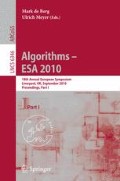Abstract
We present a multi-level graph partitioning algorithm based on the extreme idea to contract only a single edge on each level of the hierarchy. This obviates the need for a matching algorithm and promises very good partitioning quality since there are very few changes between two levels. Using an efficient data structure and new flexible ways to break local search improvements early, we obtain an algorithm that scales to large inputs and produces the best known partitioning results for many inputs. For example, in Walshaw’s well known benchmark tables we achieve 155 improvements dominating the entries for large graphs.
Partially supported by DFG grant SA 933/3-2.
Access this chapter
Tax calculation will be finalised at checkout
Purchases are for personal use only
Preview
Unable to display preview. Download preview PDF.
References
Birn, M., Holtgrewe, M., Sanders, P., Singler, J.: Simple and fast nearest neighbor search. In: 11th Workshop on Algorithm Engineering and Experiments (2010)
Davis, T.: The University of Florida Sparse Matrix Collection (2008), http://www.cise.ufl.edu/research/sparse/matrices
Delling, D., Sanders, P., Schultes, D., Wagner, D.: Engineering route planning algorithms. In: Lerner, J., Wagner, D., Zweig, K.A. (eds.) Algorithmics of Large and Complex Networks. LNCS, vol. 5515, pp. 117–139. Springer, Heidelberg (2009)
Dementiev, R., Sanders, P., Schultes, D., Sibeyn, J.: Engineering an external memory minimum spanning tree algorithm. In: IFIP TCS, Toulouse (2004)
Drake, D., Hougardy, S.: Improved linear time approximation algorithms for weighted matchings. In: Arora, S., Jansen, K., Rolim, J.D.P., Sahai, A. (eds.) RANDOM 2003 and APPROX 2003. LNCS, vol. 2764, pp. 14–23. Springer, Heidelberg (2003)
Fiduccia, C.M., Mattheyses, R.M.: A Linear-Time Heuristic for Improving Network Partitions. In: 19th Conf. on Design Automation, pp. 175–181 (1982)
Fjallstrom, P.: Algorithms for graph partitioning: A survey. Linkoping Electronic Articles in Computer and Information Science 3(10) (1998)
Karypis, V.K.G.: A fast and high quality multilevel scheme for partitioning irregular graphs. SIAM Journal on Scientific Computing 20(1), 359–392 (1998)
Geisberger, R., Sanders, P., Schultes, D.: Better approximation of betweenness centrality. In: 10th Workshop on Algorithm Engineering and Experimentation, San Francisco, pp. 90–108. SIAM, Philadelphia (2008)
Geisberger, R., Sanders, P., Schultes, D., Delling, D.: Contraction hierarchies: Faster and simpler hierarchical routing in road networks. In: McGeoch, C.C. (ed.) WEA 2008. LNCS, vol. 5038, pp. 319–333. Springer, Heidelberg (2008)
Guibas, L.J., Knuth, D.E., Sharir, M.: Randomized incremental construction of Delaunay and Voronoi diagrams. Algorithmica 7(4), 381–413 (1992)
Hendrickson, B.: Chaco: Software for partitioning graphs, http://www.sandia.gov/~bahendr/chaco.html
Holtgrewe, M.: A scalable coarsening phase for a multi-level partitioning algorithm. Diploma thesis, Universität Karlsruhe (2009)
Holtgrewe, M., Sanders, P., Schulz, C.: Engineering a scalable high quality graph partitioner. In: 24th IEEE International Parallel and Distributed Processing Symposium (to appear, 2010), arXiv:0910.2004
Karger, D.R., Stein, C.: A new approach to the minimum cut problem. J. ACM 43(4), 601–640 (1996)
Karypis, G., Kumar, V.: MeTis: Unstructured Graph Partitioning and Sparse Matrix Ordering System, Version 4.0, http://www.cs.umn.edu/~metis
Karypis, G., Kumar, V.: MeTiS, A Software Package for Partitioning Unstructured Graphs, Partitioning Meshes, and Computing Fill-Reducing Orderings of Sparse Matrices, Version 4.0 (1998)
Maue, J., Sanders, P.: Engineering algorithms for approximate weighted matching. In: Demetrescu, C. (ed.) WEA 2007. LNCS, vol. 4525, pp. 242–255. Springer, Heidelberg (2007)
Meyerhenke, H., Monien, B., Sauerwald, T.: A new diffusion-based multilevel algorithm for computing graph partitions. Journal of Parallel and Distributed Computing 69(9), 750–761 (2009)
Pellegrini, F.: SCOTCH: Static Mapping, Graph, Mesh and Hypergraph Partitioning, and Parallel and Sequential Sparse Matrix Ordering Package (2007), http://www.labri.fr/perso/pelegrin/scotch/
Pellegrini, F.: SCOTCH 5.1 User’s guide. Technical report, Laboratoire Bordelais de Recherche en Informatique, Bordeaux, France (2008)
Pettie, S., Sanders, P.: A simpler linear time 2/3 − ε approximation for maximum weight matching. Information Processing Letters 91(6), 271–276 (2004)
Preis, R.: PARTY Partitioning Library (1996), http://www2.cs.uni-paderborn.de/cs/robsy/party.html
Preis, R.: Linear time 1/2-approximation algorithm for maximum weighted matching in general graphs. In: Meinel, C., Tison, S. (eds.) STACS 1999. LNCS, vol. 1563, pp. 259–269. Springer, Heidelberg (1999)
Preis, R., Diekmann, R.: The PARTY Partitioning Library, User Guide. Technical report, University of Paderborn, Germany, Tr-rsfb-96-02 (1996)
Schloegel, K., Karypis, G., Kumar, V.: Graph partitioning for high performance scientific simulations. Technical Report 00-018, University of Minnesota (2000)
Soperm, A.J., Walshaw, C., Cross, M.: A combined evolutionary search and multilevel optimisation approach to graph partitioning. J. Global Optimization 29(2), 225–241 (2004), http://staffweb.cms.gre.ac.uk/~c.walshaw/partition/
Tavory, A., Dreizin, V., Kosnik, B.: Policy-based data structures. IBM Haifa and Redhat (2004), http://gcc.gnu.org/onlinedocs/libstdc++/ext/pb_ds/
Walshaw, C.: JOSTLE –graph partitioning software (2005), http://staffweb.cms.gre.ac.uk/~wc06/jostle/
Walshaw, C., Cross, M.: JOSTLE: Parallel Multilevel Graph-Partitioning Software – An Overview. In: Magoules, F. (ed.) Mesh Partitioning Techniques and Domain Decomposition Techniques, pp. 27–58. Civil-Comp Ltd. (2007) (invited chapter)
Author information
Authors and Affiliations
Editor information
Editors and Affiliations
Rights and permissions
Copyright information
© 2010 Springer-Verlag Berlin Heidelberg
About this paper
Cite this paper
Osipov, V., Sanders, P. (2010). n-Level Graph Partitioning. In: de Berg, M., Meyer, U. (eds) Algorithms – ESA 2010. ESA 2010. Lecture Notes in Computer Science, vol 6346. Springer, Berlin, Heidelberg. https://doi.org/10.1007/978-3-642-15775-2_24
Download citation
DOI: https://doi.org/10.1007/978-3-642-15775-2_24
Publisher Name: Springer, Berlin, Heidelberg
Print ISBN: 978-3-642-15774-5
Online ISBN: 978-3-642-15775-2
eBook Packages: Computer ScienceComputer Science (R0)

